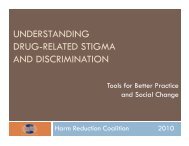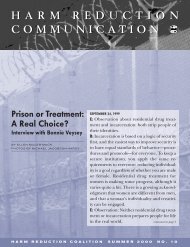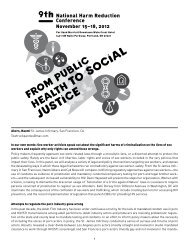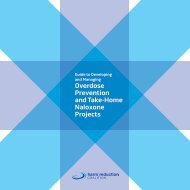PROMOTING SECONDARY EXCHANGE: - Harm Reduction Coalition
PROMOTING SECONDARY EXCHANGE: - Harm Reduction Coalition
PROMOTING SECONDARY EXCHANGE: - Harm Reduction Coalition
You also want an ePaper? Increase the reach of your titles
YUMPU automatically turns print PDFs into web optimized ePapers that Google loves.
Executive Summary<br />
Secondary exchange is an important but<br />
underemphasized component of HIV and<br />
hepatitis C prevention for injection drug users<br />
(IDUs). Secondary exchange refers to a range<br />
of formal and informal practices through<br />
which syringe exchange participants<br />
redistribute sterile syringes to peers within<br />
social and drug-using networks. Despite their<br />
remarkable success in disease prevention,<br />
syringe exchange programs (SEPs) directly<br />
reach between 5-10% of active injection<br />
drug users. With changing communities,<br />
gentrification, and shifting drug trends, it is<br />
clear that public health policies must respond<br />
by promoting practices that reach the most<br />
at-risk communities. Secondary exchange<br />
therefore facilitates access to sterile syringes<br />
for a far greater number of drug users.<br />
Syringe exchange programs and policymakers<br />
should develop policies, programs,<br />
and strategies that aggressively encourage<br />
secondary exchange. Furthermore, secondary<br />
exchange can be harnessed to disseminate<br />
accurate risk reduction and disease prevention<br />
information, encourage health-promoting<br />
social norms and behavioral change, and recruit<br />
members of drug using social networks into<br />
higher-threshold services and interventions.<br />
This report includes a set of recommendations<br />
intended to facilitate, expand, and capitalize<br />
on secondary exchange.<br />
Recommendations<br />
• Revise local, state, and program policies<br />
to maximize the public health benefits of<br />
secondary exchange. Syringe exchange<br />
regulations and policies should shift away<br />
from the one-for-one exchange paradigm and<br />
strive to ensure that exchange participants<br />
obtain adequate numbers of syringes<br />
for themselves and their peer networks.<br />
Changing polices and procedures that require<br />
caps on the number of syringes received<br />
by participants and implementing explicit<br />
strategies and campaigns to encourage and<br />
support secondary exchange will increase<br />
the number of sterile syringes available to<br />
injectors and promote community health.<br />
• Develop new models that engage secondary<br />
exchangers to enable social network<br />
interventions including HIV, hepatitis C, and<br />
overdose prevention, as well as recruitment to<br />
higher-threshold services (i.e., HIV and STD<br />
testing, hepatitis A & B vaccination, etc.).<br />
• Design gender-specific approaches to engage<br />
female recipients of secondary exchange.<br />
Promote and support women peer educators<br />
trained on risk reduction for women IDUs.<br />
• Explore strategies to ‘incentivize’ secondary<br />
exchange, including efforts to a) recognize<br />
the work of secondary exchangers within<br />
programs, b) convene special meetings,<br />
events, or trainings for secondary exchangers,<br />
and c) compensate secondary exchangers for<br />
achieving specified outreach and/or education<br />
objectives within their networks.<br />
• Develop strategies to harness the role of<br />
secondary exchangers to increase the flow<br />
of information to programs. Secondary<br />
exchangers provide valuable information<br />
concerning drug trends, law enforcement<br />
practices, and overdose rates and response<br />
patterns. Programs should also devise simple<br />
measures and estimates of the extent and<br />
reach of secondary exchange conducted by<br />
participants, either as periodic surveys or ongoing<br />
data collection.<br />
“Syringe access<br />
programs are one of the<br />
most effective methods<br />
of disease prevention<br />
among injection drug<br />
users. Over a decade’s<br />
worth of scientific<br />
research concludes<br />
that syringe exchange<br />
programs play an<br />
essential role in<br />
reducing the spread of<br />
blood-borne illnesses<br />
such as HIV and<br />
Hepatitis B and C.”<br />
• Establish greater safe disposal options for<br />
secondary exchange providers and recipients;<br />
such options include distributing individual<br />
fit-packs, providing education on needlestick<br />
injuries, and establishing community safe<br />
disposal kiosks.<br />
• Policies should promote safe disposal and<br />
education among secondary exchangers but<br />
not require secondary exchangers to collect<br />
used syringes to return at SEPs. Polices must<br />
recognize that a) IDUs employ a range of valid<br />
and safe strategies to dispose of used syringes,<br />
and b) requiring secondary exchangers to<br />
return syringes used by others may increase<br />
their risk of infection through needlestick<br />
injuries.<br />
• Syringe exchange programs, local health<br />
clinics, and community based organizations<br />
should pilot low-threshold models that train<br />
secondary exchangers as peer educators.<br />
To be effective, these models should<br />
require the minimum amount of training<br />
and documentation necessary and provide<br />
substantial flexibility to programs and<br />
participants.<br />
Background<br />
Syringe access programs are one of the most<br />
effective methods of disease prevention<br />
among injection drug users. Over a decade’s<br />
worth of scientific research concludes that<br />
syringe exchange programs play an essential<br />
role in reducing the spread of blood-borne<br />
illnesses such as HIV and hepatitis B and<br />
C. 1 Research consistently demonstrates<br />
that syringe exchange programs and overthe-counter<br />
pharmacy sales of syringes are<br />
valuable public health interventions that<br />
target ‘hard to reach’ populations of injection<br />
drug users, providing a ‘bridge’ to medical,<br />
mental health, and addiction treatment. Yet,<br />
despite documented efficacy and the positive<br />
health benefits associated with participation<br />
in a syringe exchange program, their<br />
implementation is not widespread.<br />
Social, legal, and political constraints deter<br />
the development of syringe access programs,<br />
resulting in limited access to—and circulation<br />
of—sterile syringes in many communities.<br />
Recent research suggests that while the total<br />
number of syringes exchanged is on the rise,<br />
the number of syringe exchange programs<br />
has decreased slightly. 2 Logistical barriers<br />
and finite resources suggest that, even under<br />
the most optimistic scenarios, SEPs will<br />
never directly reach more than a fraction of<br />
IDUs. A practice known as ‘secondary and<br />
satellite exchange’ is a supplementary method<br />
to increase the number of sterile syringes in<br />
circulation and reach injection drug users who<br />
are unable or unwilling to attend a syringe<br />
exchange program. 3<br />
Secondary exchange is a broad term<br />
encompassing practices that range from<br />
semi-formal arrangements among a stable<br />
peer network which one member serves<br />
as ‘designated exchanger’ for the group to<br />
more informal patterns where exchangers<br />
provide, loan, or sell syringes to peers on<br />
an as needed basis. Strategies to promote<br />
secondary distribution and exchange offer a<br />
complementary approach to increase syringe<br />
access, disseminate health promotion and<br />
disease prevention messages, and engage more<br />
IDUs.<br />
Promoting Secondary Exchange: opportunities to advance public health











